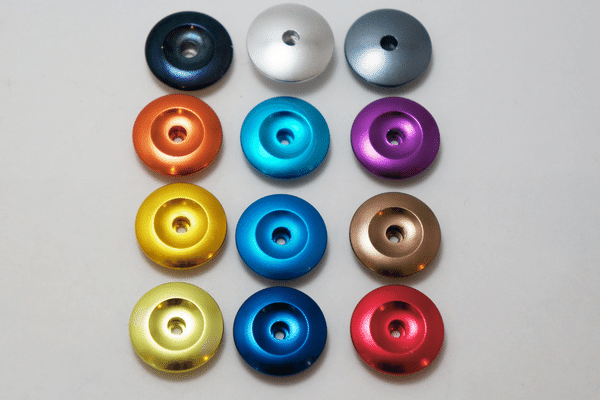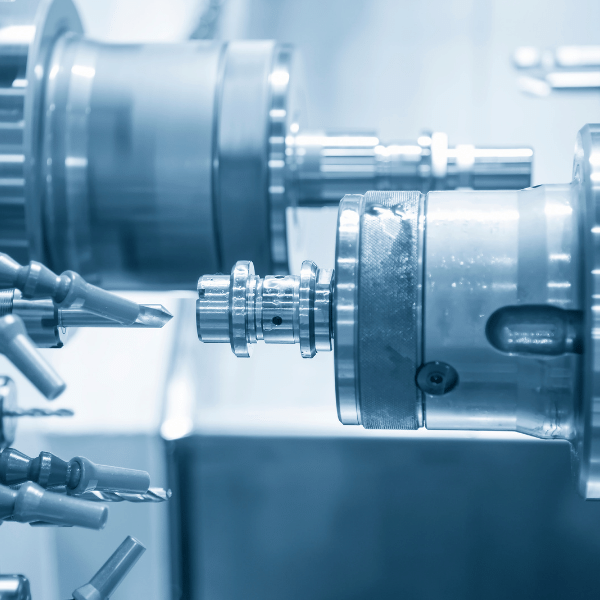What is an Aluminum Machined Part, and What Are Its Uses

An aluminum machined part is a part that has been made by removing material from a solid aluminum block using various machining processes. Milling, drilling, and turning are the most common machining processes to create aluminum machined parts. Aluminum machined parts are used in various industries and applications, including the aerospace, automotive, and medical industries.
Milling is a machining process that uses rotary cutters to remove material from a workpiece. Milling can be performed on either horizontal or vertical axes. Drilling is a machining process that uses a drill bit to create holes in a workpiece. Turning is a machining process that uses a cutting tool to remove material from a rotating workpiece.
Aluminum Machined Part Uses
Aerospace Industry: One of the most common uses for aluminum machined parts is in the aerospace industry. Aircraft and spacecraft components are often made from aluminum because it is strong yet lightweight.
Automotive Industry: Aluminum machined parts are also used in the automotive industry. Many car and truck components are made from aluminum because it is durable and corrosion-resistant.
Medical Industry: Another common use for aluminum machined parts is in the medical industry. Medical devices and implants are often made from aluminum because it is biocompatible and non-toxic.
Aluminum machined parts are created by removing material from a solid aluminum block using various machining processes, such as milling, drilling, and turning. These parts are used in many industries due to their strength, durability, corrosion resistance, and biocompatibility. If you need precision metal parts for your next project, consider using aluminum machined parts!
How Are Aluminum Machined Parts Made?
Aluminum machined parts are made by cutting and shaping aluminum using specialized tools. This process is called machining. There are different types of machining, but the most common type used to make aluminum parts is CNC.
CNC machining is where computer-controlled machines remove material from a workpiece to create the desired shape. The benefit of CNC machining is that it can create very complex shapes that would be difficult to achieve with traditional methods.
The first step in the manufacturing process is to create a computer model of the aluminum machined part. This model is created using a CAD (computer-aided design) program. Once the model is created, it is converted into a file format that the CNC machine can read.
The next step is to set up the CNC machine. This involves loading the correct file onto the machine and setting up the cutting tools. The CNC machine will then cut the aluminum piece to the desired shape.
After the part has been cut, it will need to be finished. This usually involves deburring, which removes any sharp edges from the part. Once the part has been deburred, it is ready for use.
Aluminum machined parts are made by cutting and shaping aluminum using specialized tools. The most common type of machining used to make aluminum parts is CNC machining. This type of machining can create very complex shapes that would be difficult to achieve with traditional methods.
The Different Types of Aluminum Alloys That Can Be Used to Make Machined Parts
When it comes to making machined parts, there are a variety of aluminum alloys that can be used. The most common aluminum alloy is 6061, which is strong and versatile. Other popular options include 7075, 2024, and 5052. Each alloy has its own unique set of properties that make it well-suited for specific applications.
6061 Aluminum Alloy
6061 aluminum alloy is one of the most commonly used alloys. It is known for being strong and versatile. 6061 aluminum can be heat treated, which makes it ideal for welding and machining. This alloy is often used in constructing aircraft, boats, and bicycles.
7075 Aluminum Alloy
7075 aluminum alloy is known for being one of the strongest alloys available. It is frequently used in the construction of aircraft and bicycles. This alloy can be heat treated, making it ideal for welding and machining.
2024 Aluminum Alloy
2024 aluminum alloy is known for being lightweight and strong. It is often used in the construction of aircraft. This alloy can be heat treated, making it ideal for welding and machining.
5052 Aluminum Alloy
5052 aluminum alloy is known for being corrosion-resistant. It is often used in the construction of boats and automobiles. This alloy cannot be heat treated but can be easily welded and machined.
There are a variety of aluminum alloys that can be used to make machined parts. The most common aluminum alloy is 6061, which is strong and versatile. Other popular options include 7075, 2024, and 5052. Each alloy has its own unique set of properties that make it well-suited for specific applications. When choosing an aluminum alloy for your next project, consider the end goal and desired outcome to ensure you select the best option available.
How to Choose the Right Alloy for Your Application
When it comes to aluminum alloys, there are many different options to choose from. But how do you know which one is right for your application? In this blog post, we’ll give you a rundown of the most common aluminum alloys and their most common applications so that you can make an informed decision for your next project.
Aluminum Alloy 1100
One of the most common aluminum alloys on the market, 1100 aluminum is known for its excellent weldability, formability, and corrosion resistance. It’s often used in food and beverage processing, storage tanks, chemical equipment, and marine components.
Aluminum Alloy 2011
2011 aluminum alloy is perfect for applications that require high mechanical strength and good machinability. It’s often used in aerospace components, automotive parts, and sporting goods.
Aluminum Alloy 2024
2024 aluminum alloy is frequently used in aircraft structures and components due to its high strength-to-weight ratio. It’s also utilized in truck wheels, piston rings, and valves.
Aluminum Alloy 5052
5052 aluminum alloy is known for its excellent corrosion resistance, making it a popular choice for outdoor applications such as marine components, fuel tanks, and street signs. It’s also frequently used in electronics due to its low electrical conductivity.
Aluminum Alloy 6061
6061 aluminum alloy is one of the most versatile alloys on the market. It offers good weldability, formability, and corrosion resistance while being strong and lightweight. It’s often used in applications such as bicycle frames, boat hulls, furniture, and structural components.
There are a lot of different aluminum alloys to choose from, depending on your application requirements. This blog post briefly overviews some of the most common alloys and their most popular applications. Hopefully, this will help you narrow down your choices for your next project!
Why Aluminum Machined Parts Are So Great
When it comes to machined parts, there are a lot of different materials that can be used. However, aluminum machined parts are some of the best. There are a few reasons for this. First, aluminum is strong yet lightweight. This makes it ideal for a lot of applications. Second, aluminum is corrosion-resistant. This is important because it means that your parts will last longer. Finally, aluminum can be machined to very tight tolerances. This is important because it means that your parts will fit together perfectly.
The first reason aluminum machined parts are so great is that aluminum is strong yet lightweight. This makes it ideal for a lot of applications. For example, aluminum is a good option if you need a substantial part that doesn’t weigh a lot. Another example is if you need a part that doesn’t rust easily. This is important because it means that your parts will last longer.
The second reason aluminum machined parts are so great is that they can be machined to very tight tolerances. This is important because it means that your parts will fit together perfectly. For example, if you have two pieces that need to fit perfectly, you can use an aluminum machined part. This is because the tolerances can be so tight that there will be no gap between the two pieces.
The third reason aluminum machined parts are so great is their corrosion resistance. It is important because it means that your parts will last longer. For example, if you live in an area with a lot of salt in the air, you need to use a corrosion-resistant material like aluminum for your parts. Otherwise, the salt will corrode the metal and cause the part to fail.
Aluminum machined parts are some of the best available options today. They are strong, yet lightweight, can be machined to very tight tolerances, and are corrosion-resistant. If you need a high-quality part for your application, you should consider using an aluminum machined part.
Finishes for Aluminum Parts
When it comes to aluminum machined parts, there are a variety of finishes that are available in order to create the desired look. The most common finishes are anodizing, powder coating, and wet painting. Let’s take a closer look at each of these finishes so you can decide which one is right for your project.
Anodizing
Anodizing is an electrolytic process that creates a durable, corrosion-resistant finish on aluminum. The aluminum part is placed in an acid bath, and a current is run through the bath, causing a reaction that creates a thin oxide film on the part’s surface. This film can be dyed any number of colors, making it ideal for aesthetic applications. Anodized finishes are also highly resistant to abrasion and chemicals, making them ideal for large parts of wear and tear.
Powder Coating
Powder coating is a type of finishing that uses finely ground pigment particles and resin sprayed onto the aluminum part’s surface. The part is then placed in an oven where the powder melts and flows together, creating a smooth, consistent finish. Powder coating is available in many colors and textures, making it a versatile option for both functional and decorative parts. In addition, powder coating is highly resistant to chipping, scratching, and fading, making it an ideal choice for parts that will be exposed to the elements or handled frequently.
Wet Painting
Wet painting is a finishing process in which paint is applied to the surface of the aluminum part using either a brush or spray gun. Wet painting offers a wide range of color options and can create either a glossy or matte finish, depending on the type of paint used. Wet painting is less durable than anodizing or powder coating but is more affordable and can be completed in a shorter time frame. Wet painting is typically used for smaller parts or parts that will not be subject to heavy wear and tear.
When it comes to choosing a finish for your aluminum machined part, there are several factors to consider including durability, color selection, cost, and lead time. Anodizing offers superior durability and color selection but comes at a higher cost and with a longer lead time. Powder coating provides good durability at a lower cost but has fewer color options than anodizing. Wet painting is the most affordable option but has the shortest lifespan. Ultimately, the best finish for your project will depend on your specific needs and requirements.







